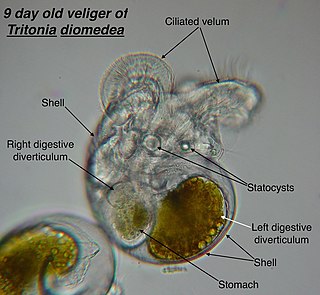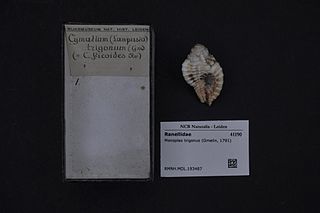
Gastropods, commonly known as slugs and snails, belong to a large taxonomic class of invertebrates within the phylum Mollusca called Gastropoda.

A veliger is the planktonic larva of many kinds of sea snails and freshwater snails, as well as most bivalve molluscs (clams) and tusk shells.

Rapana venosa, common name the veined rapa whelk or Asian rapa whelk, is a species of large predatory sea snail, a marine gastropod mollusc or whelk, in the family Muricidae, the rock shells.

Calliostoma ligatum, common name the blue top snail, is a small prosobranch trochid gastropod mollusk in the family Calliostomatidae, the Calliostoma top snails.

Monoplex parthenopeus, common name the giant triton or giant hairy triton, is a species of sea snail, a marine gastropod mollusk in the family Cymatiidae. It preys on other molluscs.

Charonia variegata, the Atlantic triton or Atlantic triton's trumpet, is a species of predatory sea snail, a marine gastropod mollusk in the family Charoniidae, the triton snails, triton shells, or tritons.
Fusitriton brasiliensis is a species of predatory sea snail, a marine gastropod mollusk in the family Cymatiidae.

Monoplex aquatilis, common name the cosmopolitan hairy triton, is a species of predatory sea snail, a marine gastropod mollusk in the family Cymatiidae.

Monoplex pilearis, common name the hairy triton, is a species of medium-sized predatory sea snail, a marine gastropod mollusk in the family Cymatiidae.

Monoplex tranquebaricus, common name: the West African hairy triton, is a species of predatory sea snail, a marine gastropod mollusk in the family Cymatiidae.

Monoplex trigonus, common name the trigonal hairy triton, is a species of predatory sea snail, a marine gastropod mollusk in the family Cymatiidae.

Monoplex vespaceus, common name the dwarf hairy triton, is a species of predatory sea snail, a marine gastropod mollusk in the family Cymatiidae.

Priene scabrum is a species of predatory sea snail, a marine gastropod mollusk in the family Ranellidae, the triton snails, triton shells or tritons.

Linatella caudata, common name : the Girdled triton or Poulsen's Triton, is a species of predatory sea snail, a marine gastropod mollusk in the family Cymatiidae.

Ranularia sarcostoma, common name : the flesh-coloured hairy triton, is a species of predatory sea snail, a marine gastropod mollusk in the family Cymatiidae.

Argobuccinum is a genus of predatory sea snails, marine gastropod mollusks in the family Cymatiidae.

Conradia is a genus of very small sea snails or micromolluscs, marine gastropod molluscs in the family Conradiidae.

Margarites pupillus, common name the puppet margarite or the little margarite, is a species of sea snail, a marine gastropod mollusk in the family Margaritidae, the turban snails.

Kelletia kelletii, common name Kellet's whelk, is a species of large sea snail, a whelk, a marine gastropod mollusc in the family Buccinidae, the true whelks.

Halocynthia igaboja, commonly known as sea hedgehog, bristly tunicate or spiny sea squirt, is a species of tunicate in the family Pyuridae. It is native to the northeastern Pacific Ocean. This species was first described in 1906 by the Japanese marine biologist Asajiro Oka, who gave it the name Cynthia ritteri. It was later transferred to the genus Halocynthia.























